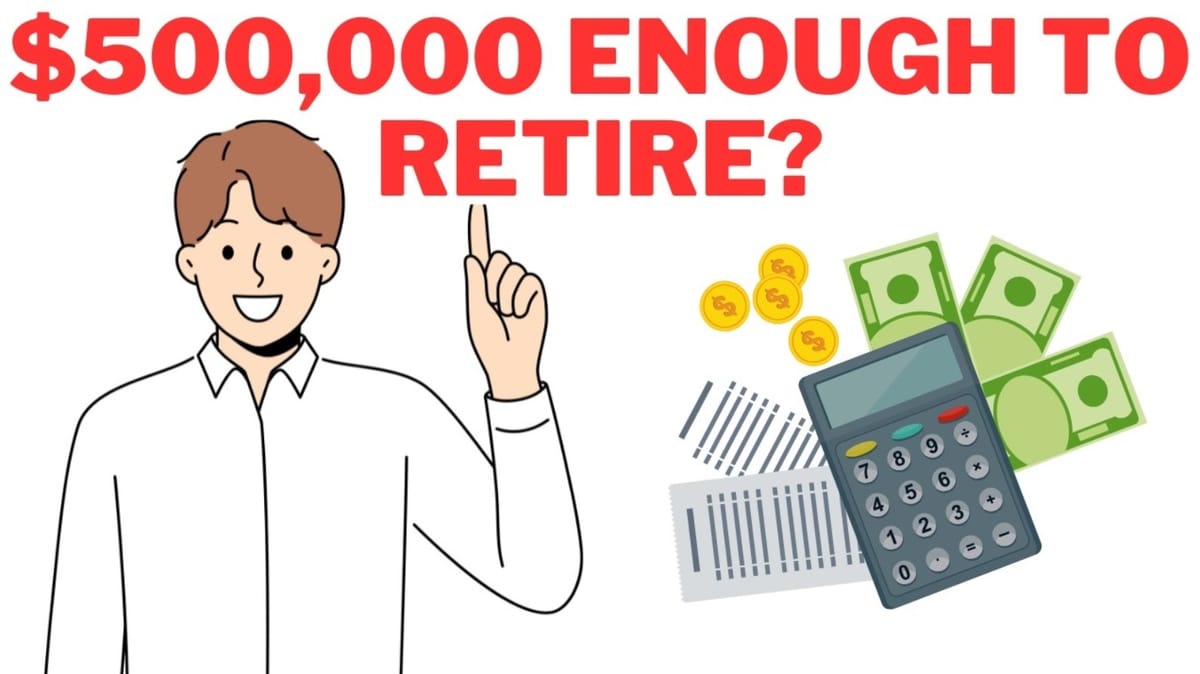Is It Possible to Retire at 45 With $500,000?

Many people dream of early retirement, but is it possible to retire at 45 with $500,000? The answer depends on several factors such as your expenses, investment returns, and additional income sources. While $500,000 may not seem like much for a multi-decade retirement, with the right financial strategy, it can be feasible.
This article will explore whether retiring at 45 with $500,000 is realistic, the challenges you might face, and strategies to make your money last.
Can You Retire at 45 With $500,000?

The possibility of retiring at 45 with $500,000 depends on:
- Your annual expenses – Can you live on a limited budget?
- Investment growth – Will your investments generate enough income?
- Other income sources – Do you have rental income, dividends, or a side hustle?
- Lifestyle choices – Are you willing to live frugally?
A widely used rule, the 4% withdrawal rule, suggests that withdrawing 4% of your savings annually should sustain your retirement. With $500,000, that equates to $20,000 per year. If you can live within this budget, early retirement could be possible.
However, there are risks, including inflation, unexpected expenses, and investment fluctuations, that could deplete your savings faster than expected.
How Long Will $500,000 Last in Retirement?

The 4% Rule and Its Limitations
The 4% rule assumes:
- A 7% average investment return
- A balanced stock-bond portfolio
- A 30-year retirement period
Since retiring at 45 means potentially 40+ years of retirement, the 4% rule might not be enough. Reducing the withdrawal rate to 3-3.5% may provide more security:
- 3% withdrawal rate: $15,000 per year
- 3.5% withdrawal rate: $17,500 per year
Factors That Affect Longevity of Savings
- Market downturns – A stock market crash can shrink your savings.
- Inflation – The rising cost of living erodes purchasing power.
- Unexpected expenses – Medical costs or home repairs can drain funds.
- Longevity – The longer you live, the more you’ll need.
How Much Do You Need to Live Comfortably?
Cost of Living Considerations
Where you live greatly impacts how far $500,000 can take you. Some low-cost locations include:
Affordable U.S. States:
- Texas
- Florida
- Tennessee
International Retirement Destinations:
- Thailand
- Mexico
- Portugal
Moving to a low-cost region helps stretch your retirement savings significantly.
Example Monthly Budget on $500,000
Here’s a frugal budget to survive on $20,000 per year:
| Expense | Monthly Cost | Annual Cost |
|---|---|---|
| Housing | $500 | $6,000 |
| Food | $300 | $3,600 |
| Healthcare | $250 | $3,000 |
| Transportation | $150 | $1,800 |
| Entertainment | $100 | $1,200 |
| Miscellaneous | $100 | $1,200 |
| Total | $1,400 | $16,800 |
This budget provides a small safety buffer, but it requires strict spending discipline.
Investment Strategies to Make $500,000 Last
1. Stock Market Investments
Investing in index funds, ETFs, and dividend stocks can provide passive income while maintaining capital growth.
- S&P 500 Index Funds – Long-term growth potential
- Dividend Stocks – Generate steady income
- Bonds & REITs – Lower-risk investments for stability
2. Real Estate Investments
- Rental Properties – Monthly rental income
- Real Estate Investment Trusts (REITs) – Passive real estate investing
- House Hacking – Rent out part of your home for income
3. Side Income Streams
A small side hustle can significantly extend your retirement savings:
- Freelancing (writing, consulting, tutoring)
- Part-time work (remote jobs, seasonal work)
- Passive income (royalties, affiliate marketing, online courses)
Even an additional $500–$1,000 per month can make a big difference.
Challenges and Risks of Retiring at 45 With $500,000
1. Inflation
A 3% annual inflation rate reduces purchasing power over time. $20,000 today may not be enough in 20 years.
2. Healthcare Costs
Without employer-sponsored insurance, healthcare can be expensive. Options include:
- Health Savings Account (HSA) – Tax-advantaged savings
- Affordable Care Act (ACA) plans – Government-subsidized options
- Medical tourism – Cheaper healthcare abroad
3. Market Crashes
A stock market downturn early in retirement can deplete funds faster than expected.
Strategies to Mitigate Risk:
- Maintain 1-3 years of cash reserves
- Invest in low-volatility assets
4. Social Security Timing
Social Security benefits aren’t available until at least 62 years old, leaving a gap in income.
How to Increase Your Chances of Early Retirement Success
1. Reduce Expenses
- Move to a lower-cost area
- Downsize your home
- Cut unnecessary spending
2. Maximize Passive Income
- Invest in dividend stocks
- Own rental properties
- Start a small online business
3. Delay Large Withdrawals
- Work part-time for a few years
- Withdraw from taxable accounts first
FAQs
Is $500,000 enough to retire at 45?
It depends on your expenses, investment returns, and lifestyle choices. If you can live on $15,000–$20,000 annually, it’s possible.
What happens if my investments lose value?
A market downturn can reduce savings. Keeping a cash cushion and investing in low-volatility assets helps mitigate risks.
Can I still work after retiring?
Yes. Many retirees take on part-time work or freelancing to supplement income.
How do I handle healthcare costs?
Without employer insurance, you’ll need ACA plans, HSAs, or medical tourism to manage expenses affordably.
Should I move to a lower-cost country?
Yes. Countries like Mexico, Thailand, and Portugal offer lower living costs and quality healthcare.
What’s the safest withdrawal rate?
For early retirees, 3-3.5% is safer than 4%, ensuring your savings last longer.
Conclusion
So, is it possible to retire at 45 with $500,000? Yes—but only with smart financial planning, disciplined spending, and diversified income sources.
Early retirement requires low living costs, passive income, and careful investment management. If you are flexible with your lifestyle and have backup plans, retiring at 45 with $500,000 can be a reality.




